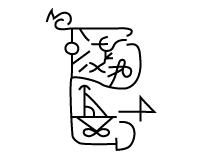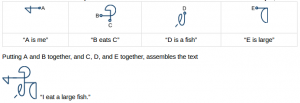Unker Non-Linear Writing System by Alex Fink & Sai.
From the webpage:
“I understood from my parents, as they did from their parents, etc., that they became happier as they more fully grokked and were grokked by their cat.”[3]
Here is another snippet from the text:
Binding points, lines and relations
Every glyph includes a number of binding points, one for each of its arguments, the semantic roles involved in its meaning. For instance, the glyph glossed as eat has two binding points—one for the thing consumed and one for the consumer. The glyph glossed as (be) fish has only one, the fish. Often we give glosses more like “X eat Y”, so as to give names for the binding points (X is eater, Y is eaten).
A basic utterance in UNLWS is put together by writing out a number of glyphs (without overlaps) and joining up their binding points with lines. When two binding points are connected, this means the entities filling those semantic roles of the glyphs involved coincide. Thus when the ‘consumed’ binding point of eat is connected to the only binding point of fish, the connection refers to an eaten fish.
This is the main mechanism by which UNLWS clauses are assembled. To take a worked example, here are four glyphs:
If you are interested in graphical representations for design or presentation, this may be of interest.
Sam Hunting forwarded this while we were exploring TeX graphics.
PS: The “cat” people on Twitter may appreciate the first graphic. 😉

